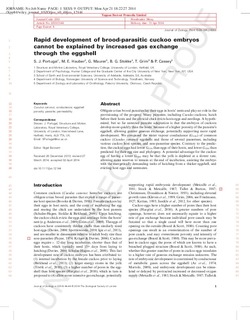| dc.contributor.author | Portugal, Steven J. | |
| dc.contributor.author | Hauber, Mark E. | |
| dc.contributor.author | Maurer, Golo | |
| dc.contributor.author | Stokke, Bård Gunnar | |
| dc.contributor.author | Grim, Tomas | |
| dc.contributor.author | Cassey, Phillip | |
| dc.coverage.spatial | This is the peer reviewed version of the following article: [Rapid development of brood-parasitic cuckoo embryos cannot be explained by increased gas exchange through the eggshell], which has been published in final form at [http://onlinelibrary.wiley.com/doi/10.1111/jzo.12144/abstract]. This article may be used for non-commercial purposes in accordance with Wiley Terms and Conditions for Self-Archiving. | nb_NO |
| dc.date.accessioned | 2017-10-25T13:14:59Z | |
| dc.date.available | 2017-10-25T13:14:59Z | |
| dc.date.created | 2014-02-07T09:11:09Z | |
| dc.date.issued | 2014 | |
| dc.identifier.citation | Journal of Zoology. 2014, 293 (4), 219-226. | nb_NO |
| dc.identifier.issn | 0952-8369 | |
| dc.identifier.uri | http://hdl.handle.net/11250/2462157 | |
| dc.description.abstract | Obligate avian brood parasites lay their eggs in hosts' nests and play no role in the provisioning of the progeny. Many parasites, including Cuculus cuckoos, hatch before their hosts and the altricial chick evicts hosts eggs and nestlings. A hypothesized, but so far untested parasite adaptation is that the embryos of cuckoos develop more quickly than the hosts' because the higher porosity of the parasite's eggshell allows greater gaseous exchange, potentially supporting more rapid development. We compared the water vapour conductance (GH2O) of common cuckoo (Cuculus canorus) eggshells and those of several passerines, including various cuckoo host species, and non-passerine species. Contrary to the prediction, the cuckoo eggs had lower GH2O than eggs of their hosts, and lower GH2O than predicted for their egg size and phylogeny. A potential advantage for the cuckoo egg of having a lower GH2O may be that the yolk is depleted at a slower rate, allowing more reserves to remain at the end of incubation, assisting the embryo with the energetically demanding tasks of hatching from a thicker eggshell, and evicting host eggs and nestmates. | nb_NO |
| dc.language.iso | eng | nb_NO |
| dc.publisher | Wiley | nb_NO |
| dc.title | Rapid development of brood-parasitic cuckoo embryos cannot be explained by increased gas exchange through the eggshell | nb_NO |
| dc.type | Journal article | nb_NO |
| dc.type | Peer reviewed | nb_NO |
| dc.description.version | acceptedVersion | nb_NO |
| dc.source.pagenumber | 219-226 | nb_NO |
| dc.source.volume | 293 | nb_NO |
| dc.source.journal | Journal of Zoology | nb_NO |
| dc.source.issue | 4 | nb_NO |
| dc.identifier.doi | 10.1111/jzo.12144 | |
| dc.identifier.cristin | 1110551 | |
| dc.relation.project | Norges forskningsråd: 218144 | nb_NO |
| cristin.unitcode | 194,66,10,0 | |
| cristin.unitname | Institutt for biologi | |
| cristin.ispublished | true | |
| cristin.fulltext | postprint | |
| cristin.fulltext | original | |
| cristin.qualitycode | 1 | |
